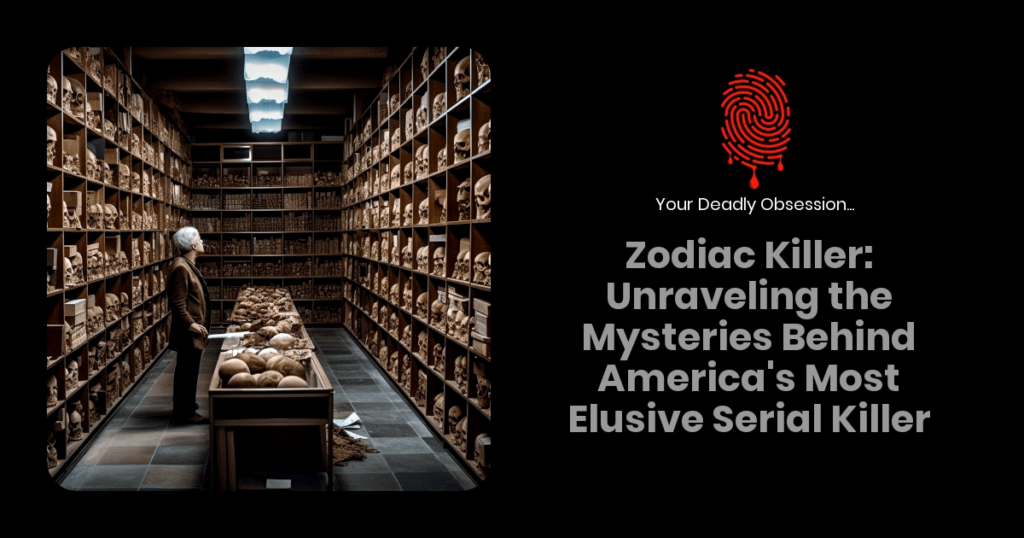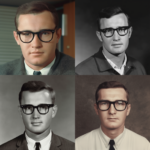The Zodiac Killer is one of the most infamous and enigmatic serial killers in American history. During the 1960s and 1970s, this mysterious individual terrorized Northern California, leaving a trail of terror and murder in his wake. Despite never being caught, the Zodiac Killer left behind a series of cryptic messages, daring law enforcement to catch him and entrancing the public for decades to come.

One of the most fascinating aspects of the Zodiac Killer story is the complex mix of true crime, urban legend, and modern mythology that has emerged around the case. Whether you’re a true crime aficionado or someone who loves a good mystery, the Zodiac Killer saga is an enthralling tale that continues to captivate audiences today.
In this article, we’ll delve into the chilling story of the Zodiac Killer, examining his gruesome crimes, his twisted communications with the police and the media, and the numerous theories that have been proposed about his identity. As we venture into the dark world of the Zodiac, prepare to be both fascinated and terrified by this enduring unsolved mystery.
The Mysterious Zodiac Killer: A Brief Overview
The Zodiac Killer is a name that still sends chills down the spines of true crime enthusiasts. From the late 1960s to the early 1970s, this mysterious murderer gripped Northern California in fear, taunting police and the public with enigmatic ciphers, letters, and brutal slayings.
The Nightmares Begin
The Zodiac Killer’s grim work began in December 1968, with the double murder of a young couple in Benicia, California. Then, in July 1969, another pair of victims were shot in a remote parking lot in Vallejo, California. The killer’s notoriety grew as he continued to:
- Claim responsibility for the attacks
- Send letters to newspapers revealing details only the killer would know
- Include cryptograms and ciphers in his communications
The Victims
Although the Zodiac Killer boasted of having killed as many as 37 people, only seven victims were confirmed, out of which two narrowly managed to survive the vicious attacks. The confirmed victims include:
- David Faraday and Betty Lou Jensen (Benicia, December 1968)
- Darlene Ferrin and Mike Mageau (Vallejo, July 1969)
- Bryan Hartnell and Cecelia Shepard (Napa County, September 1969)
- Paul Stine (San Francisco, October 1969)
The Ciphers
Mysterious cyphers and coded messages were a chilling trademark of the Zodiac Killer. He sent a total of four encrypted messages; only one has been definitively solved, known as the 408-cipher. The remaining three remain among the world’s greatest unsolved mysteries:
- The 408-cipher: Solved by a couple in 1969
- The Z-13: May potentially reveal the Zodiac’s name
- The Z-32: Associated with a map of the San Francisco Bay Area
- The Z-340: Cracked in 2020, 51 years after it was originally sent
Despite this recent breakthrough, the Zodiac Killer’s identity remains unknown.

The Suspects
Over the years, many potential suspects have come under scrutiny, some more promising than others. A few of the most notable suspects are:
- Arthur Leigh Allen: A prime suspect in the 1970s, but never conclusively linked
- Richard Gaikowski: Alleged to have been identified by surviving victim Harvey Hines
- Ross Sullivan: Linked by suspicions of code expertise
- Lawrence Kane: Known for using aliases and possessing cryptogram know-how
- Earl Van Best Jr.: Proposed by an author claiming to be his estranged son
While each suspect has generated considerable interest or speculation, definitive answers have eluded investigators, and the mystery of the Zodiac Killer’s identity remains to this day.
Chilling Letters and Cryptograms
The Zodiac Killer was infamous not only for the brutal murders but also for the complex codes and chilling letters he sent to the media and the police. These cryptograms and taunts added a terrifying layer to the ongoing investigations surrounding the mysterious killer.
The Zodiac’s First Cryptograms
The first cryptograms from the Zodiac Killer were sent in three parts to three different newspapers on July 31, 1969. The killer demanded that each newspaper print their portion of the encoded message on the front page:
- The Vallejo Times-Herald
- The San Francisco Chronicle
- The San Francisco Examiner
He threatened that if they didn’t comply, he would go on a killing spree. All three newspapers published the messages, sparking massive public interest in deciphering the code.
The 408-symbol Cipher and its Decryption
The three-part message was a single coded message containing 408 symbols. It became known as the “408-symbol cipher” and was eventually cracked by a couple from Salinas, California:
- Name: Donald and Bettye Harden
- Profession: School teacher and newspaper employee
- Decryption Date: August 8, 1969 (only a week later)
Here’s a sample of the decoded message:
I LIKE KILLING PEOPLE BECAUSE IT IS SO MUCH FUN IT IS MORE FUN THAN KILLING WILD GAME IN THE FOREST...The entire decoded message revealed the Zodiac’s twisted enjoyment of killing and hinted that his identity could be found in one of the encrypted sections. However, no definite identity was discovered from the code.
Other Coded Messages
The Zodiac Killer went on to send more cryptograms, but not all of them have been solved. Here are a few examples:
- The 340-symbol cipher: Sent on November 8, 1969. Deciphered over 51 years after its receipt, on December 11, 2020.
- The 13-symbol cipher: Sent on April 20, 1970. A possible solution was proposed in 2021 but remains unverified.
- The “My Name Is” cipher: A 13-symbol message attached to a Halloween Card on October 27, 1970. The cipher has not been solved.
The Chilling Letters
Along with the codes, the Zodiac Killer also sent terrifying letters describing the details of the murders he’d committed and taunting the police for their inability to catch him. These letters only added to the fear and fascination surrounding this cold-blooded killer.
In these chilling communications with the media and authorities, the Zodiac Killer showcased his twisted mind and cryptic nature, creating a dark legacy that continues to haunt true crime enthusiasts and investigators to this day.
Confirmed and Suspected Victims
The enigmatic Zodiac Killer, who terrorized Northern California during the late 1960s and early 1970s, remains one of the most infamous unidentified serial killers in history. Known for sending encoded messages to newspapers, the killer claimed responsibility for multiple attacks in the San Francisco Bay Area. In this section, we’ll delve into the Zodiac’s confirmed victims and those believed to be associated with his notorious killing spree.
Confirmed Victims
Five deaths and two injured victims have been definitively linked to the Zodiac. These harrowing attacks occurred between December 1968 and October 1969.
- David Faraday and Betty Lou Jensen: The Zodiac’s first known attack occurred on December 20, 1968, in which David (17) and Betty Lou (16) were fatally shot while parked along Lake Herman Road in Solano County.
- Michael Mageau and Darlene Ferrin: On July 5, 1969, the Zodiac struck again, targeting the couple Michael (19) and Darlene (22) in a parking lot in Vallejo, California. Michael Mageau survived the shooting but was severely injured, while Darlene Ferrin sadly succumbed to her injuries.
- Bryan Hartnell and Cecelia Shepard: In one of his most infamous attacks, the Zodiac Killer targeted college students Bryan (20) and Cecelia (22) during their picnic at Lake Berryessa on September 27, 1969. Bryan Hartnell survived the attack, but Cecelia passed away from her injuries two days later.
- Paul Stine: The Zodiac’s last confirmed murder happened on October 11, 1969, in San Francisco. Paul Stine (29), a cab driver, was shot in the head as he drove the Zodiac through the city’s Presidio Heights neighborhood.
Suspected Victims
In addition to the confirmed victims, authorities have also considered several other cases as potentially linked to the Zodiac Killer. However, they have never been definitively connected to the infamous murderer.
- Cheri Jo Bates: On October 30, 1966, 18-year-old Cheri Jo was found murdered near Riverside City College in Southern California. While her case has striking similarities, her connection to the Zodiac Killer remains unproven.
- Robert Domingos and Linda Edwards: The 1963 murders of Robert (18) and Linda (17) in Santa Barbara County also carry hallmarks of the Zodiac. However, no direct link to the killer has ever been confirmed.
- Donna Lass: Last seen on September 6, 1970, 25-year-old nurse Donna Lass has often been rumored to be one of the Zodiac’s victims. Her case remains unsolved, but connections to the Zodiac Killer are still speculative.
The captivating case of the Zodiac Killer continues to draw intrigue and speculation among true crime aficionados. Despite the passage of time, the true extent of the Zodiac’s crimes remains shrouded in uncertainty, leaving questions only the mysterious murderer can answer.
The Zodiac Killer’s Possible Motivations
When it comes to understanding the motives behind the Zodiac Killer’s heinous acts, we are left with only speculation and theories. However, there are some common psychological factors to consider when dealing with serial killers. Let’s discuss a few possibilities that may have driven the Zodiac Killer to commit those infamous murders.
Thrill-Seeking
One possible explanation for the Zodiac Killer’s actions is that he was looking for excitement and thrills by committing murder. This could be the case as:
- He frequently taunted the police and media by sending cryptic letters and ciphers.
- He deliberately chose different methods and weapons to carry out his crimes.
Desire for Control and Power
The Zodiac Killer’s actions could also indicate a strong desire for power and control, which is a common motivation for many serial killers. This was evident in:
- The way he manipulated and dictated the course of the investigation through his communications.
- The various situations in which he carried out his murders, often subduing and controlling his victims.
Fantasy-Driven
The killer may have been motivated by fantasies, as some serial killers are driven to kill in order to act out their darkest fantasies. This theory is supported by:
- The creative and imaginative ciphers he created, which could indicate an active fantasy life.
- His self-proclaimed nickname “Zodiac” and use of a symbol, which added a mysterious and theatrical element to his crimes.
Seeking Attention and Notoriety
Lastly, the Zodiac Killer may have been motivated by a desire for attention and notoriety. Clues that support this theory include:
- His continuous communications with the media, ensuring his crimes remained in the public eye.
- His choice to use the media as a platform to send his encoded letters, making sure his voice was heard and his crimes discussed widely.
In conclusion, while the exact motivations of the Zodiac Killer remain unknown, these possibilities can help us better understand the psyche of this infamous and enigmatic murderer.
Notorious Suspects in the Case
The Zodiac Killer case has witnessed numerous suspects across the years. However, a few of them have gained significant attention, either due to law enforcement’s focus or striking personality traits. In this section, we’ll take a closer look at some of the most notorious suspects:
Arthur Leigh Allen
- One of the main suspects in the Zodiac Killer case
- Served in the U.S. Navy and worked as a schoolteacher
- Peer and family accusations, along with investigation discoveries, bolstered suspicion
- Eventually, inconclusive DNA and handwriting evidence diminished the focus on Allen
Arthur Leigh Allen is arguably the most famous suspect in the Zodiac Killer case. His former acquaintances and family members implicated him in the case, and investigators found several suspicious items during a search of his residence. However, despite the damning circumstantial evidence, definitive DNA and handwriting tests failed to link Allen to the Zodiac crimes.
Richard Gaikowski
- An enigmatic figure with an uncanny resemblance to the Zodiac Killer’s composite sketch
- Worked for the Vallejo Times-Herald, a newspaper that received Zodiac letters
- Gaikowski’s friend, Blaine T. Blaine, accused him of being the Zodiac Killer
Richard Gaikowski, a journalist and filmmaker, emerged as a suspect after his friend Blaine T. Blaine accused him of being the Zodiac. Although Gaikowski’s background and employer are an intriguing connection to the Zodiac case, no conclusive evidence ties him to the murders.
Ross Sullivan
- A quiet and intelligent individual who studied cryptology
- Developments in the case led to a renewed interest in Sullivan as a suspect
- Sullivan’s physical appearance resembled one of the composite sketches
Ross Sullivan is another suspect in the Zodiac Killer case who gained attention due to his knowledge of cryptography and resemblance to a composite sketch. While his background and knowledge align well with the Zodiac case, authorities have yet to find compelling evidence connecting him to the crimes.
Lawrence Kane
- Worked in a print shop and had knowledge of naval codes
- Several key connections to the Zodiac case
- Linked to other cold cases, adding to his notoriety
Lawrence Kane, who worked in a print shop, emerged as a suspect due to his knowledge of naval codes and potential connections to the Zodiac Killer’s victims. Additionally, Kane has been linked to multiple other cold cases, further enhancing his notoriety.
While many suspects have been investigated, there remains no definitive confirmation of the Zodiac Killer’s identity. The mystery continues to captivate true crime enthusiasts, and we can only hope that one day this infamous case will be solved.
Conspiracy Theories Surrounding the Zodiac Killer
Like any intriguing mystery or cold case, the Zodiac Killer has been the subject of numerous conspiracy theories over the years. The following are some of the most notable theories that have sprung up as people look for answers:
- The CIA Connection: Some believe the Zodiac Killer might have been a CIA agent or at least someone with connections to the intelligence community. Proponents of this theory argue that the killer exhibited advanced knowledge in cryptography and code-breaking, which could indicate professional training. They also suggest that the mysterious and obscure nature of the case suited the shadowy world of espionage, and that the CIA possibly played a role in covering up the killer’s true identity.
- The Cheri Jo Bates Connection: One significant theory revolves around the 1966 murder of Cheri Jo Bates in Riverside, California, which some believe could be connected to the Zodiac Killer. Supporters of this theory argue that both cases have strikingly similar elements:
- Cryptic messages sent to authorities and news outlets
- Revealing details of how the murders were executed
- Gloating about the killer’s ability to elude capture
This theory posits that Bates was an early victim of the Zodiac Killer, and her murder served as a blueprint for creating his persona and modus operandi.
- Multiple Killers Theory: This theory suggests that there were multiple killers operating under the guise of the Zodiac Killer. Some proponents of this theory believe that police could have mistaken the work of separate killers, possibly even a team of killers, for the Zodiac’s due to similarities in the crimes. Additionally, some theorists argue that the perceived differences in handwriting and modus operandi between different Zodiac cases support this possibility.
- The Unabomber Connection: A more recent theory tries to link the Zodiac Killer and the Unabomber, Ted Kaczynski. While both were active around the same time and used codes and ciphers in their communications, the details of their crimes are notably different. Despite this, some still argue that they could have been influenced by one another or connected in some way, fueling this conspiracy theory.
It’s important to note that, until new evidence or a breakthrough in the case happens, these theories remain fascinating conjectures that tantalize mystery enthusiasts and die-hard fans of cold cases. As interest in the Zodiac Killer endures, we can expect these and other conspiracy theories to continue cropping up for years to come.
How the Zodiac Case Affected Popular Culture
The Zodiac Killer case has had a significant impact on popular culture, leaving a lasting impression on many aspects of society. In this section, we’ll explore how this notorious serial killer has influenced films, television, music, and even our vocabulary.
Films and Television
The Zodiac Killer’s infamous crimes have attracted the attention of filmmakers and television producers alike, resulting in several adaptations and portrayals of the case:
- The 1971 film Dirty Harry, starring Clint Eastwood, features a killer called Scorpio, widely believed to be inspired by the Zodiac.
- Zodiac (2007), directed by David Fincher and based on Robert Graysmith’s book, delves deep into the investigation of the murders and the obsession with decoding the killer’s cryptograms.
- Television series American Horror Story: Hotel (2015) includes a storyline involving the Zodiac Killer attending a secret meeting of infamous serial killers.
- The Zodiac (2005) and The Curse of the Zodiac (2007) are two lesser-known films that also tackle the unsolved mystery.
Music
The Zodiac murders have inspired several songs and bands, showing the reach of the case into the world of music:
- The rock band The Zodiac Killers took their name directly from the case.
- “Zodiac” by+Melvins references aspects of the case and cryptograms_ in its lyrics.
- Alternative rock band Pearl Jam included a song called “Gonna See My Friend” on their album Backspacer which makes a vague reference to the Zodiac Killer.
Language and Vocabulary
The Zodiac case also made its way into our everyday language and vocabulary:
- The use of the term “Zodiac” to describe a killer whose identity remains unknown has become commonplace, even though the term was coined by the killer to describe himself.
- Some parts of the killer’s cryptograms have been adopted as symbols or references related to the case, such as the “cross-circle” symbol.
Overall, the Zodiac Killer case has left an indelible mark on popular culture, continuing to captivate the public’s imagination and inspire new works in film, television, and music. Its impact serves as a testament to the case’s enduring intrigue and fascination with the unknown.
Ongoing Investigations and New Clues
In recent years, the Zodiac Killer case has seen a resurgence of interest as investigators continue to search for answers and new clues emerge with the help of modern technology. This section will delve into the ongoing investigations and recent discoveries surrounding this infamous mystery.
- New technology and code breaking: Advances in technology have enabled both professional and amateur sleuths to re-examine the Zodiac Killer’s cryptic messages, leading to potential breakthroughs in the case. For instance, in December 2020, a team of codebreakers finally decrypted the Zodiac’s 340-character cipher after 51 years. This major development revived interest in the case and provided new insights into the killer’s motives and identity.
- DNA and genealogy research: One of the more promising avenues of investigation involves the use of DNA evidence and genealogical research. In 2018, law enforcement agencies in California began to re-test old evidence, such as envelopes and stamps used by the Zodiac Killer, for potential DNA traces that could lead to the killer’s identity. This approach has already proven successful in identifying the Golden State Killer, giving hope that a similar breakthrough could be achieved in the Zodiac case.
- Re-examination of evidence and suspects: As part of ongoing investigations, authorities have continued to review and re-evaluate existing evidence and suspects. This has led to the elimination of several previous persons of interest and the emergence of new potential suspects.
- Public interest and collaboration: The enduring fascination with the Zodiac Killer has led to countless amateur detectives dedicating their time and expertise to unraveling the case. Through online forums, podcasts, and documentaries, this global community collaborates and shares new theories and discoveries, feeding into official investigations and helping to keep the case alive.
In conclusion, the hunt for the Zodiac Killer continues with renewed interest and enthusiasm from both official investigators and amateur sleuths. As technology advances and new clues come to light, there is a growing sense of optimism that one of the most enduring mysteries in American crime history could eventually be solved.
Will the Zodiac Killer’s Identity Ever Be Discovered?
The hunt for the Zodiac Killer has persisted for decades, with countless leads and theories emerging. However, none have definitively identified the killer. Die-hard fans of cold cases, crime, and mystery still hold out hope that the Zodiac Killer’s identity will one day be uncovered. This section explores the possibilities and challenges:
- Modern technology, especially advancements in DNA analysis techniques, offers renewed hope for solving this case. For example, the 2018 identification of the Golden State Killer was groundbreaking and increased the hopes for solving other mysterious cases such as the Zodiac.
- The Zodiac Killer left so many tantalizing clues, including the infamous ciphers. The recent decoding of the Z340 Cipher, solved only in December 2020, supports the idea that the Zodiac Killer’s identity might eventually be discovered through this method.
- Despite the optimism surrounding technological advancement and deciphering ciphers, there are still significant obstacles in discovering the Zodiac Killer’s identity:
- Lost Evidence: Over the years, some pieces of evidence have been lost, potentially damaging the chances of identifying the killer.
- Decades-old DNA samples: The remaining DNA samples, if any, are old and might have degraded over time. This could make it difficult to get a conclusive match with potential suspects.
- No living witnesses: The passage of time also means that witnesses and investigators who worked on the case have either passed away or may have trouble recalling specific details. This fact also affects the ability of identifying the killer.
In the end, the question of whether the Zodiac Killer’s identity will ever be discovered remains uncertain. The advancements in technology and ongoing dedication from cold case enthusiasts might yet lead to a breakthrough one day. Until then, fans of the Zodiac mystery will continue researching, theorizing, and hoping for a resolution.
What is the Zodiac Killer’s real name?

The Zodiac Killer’s real name remains unknown to this day. Despite numerous investigations and suspects, the killer’s true identity has never been conclusively determined.
When was the last Zodiac killing?
The last confirmed Zodiac killing occurred on October 11, 1969, when taxi driver Paul Stine was murdered in San Francisco. However, the Zodiac Killer claimed responsibility for more murders in subsequent letters, but these claims remain unverified.
Conclusion: The Zodiac Killer’s Enduring Legacy
The Zodiac Killer’s case has fascinated and captivated audiences for over five decades. As one of the most infamous cold cases in history, the Zodiac Killer’s identity remains unknown, and the cryptograms left behind continue to spark interest in codebreakers and crime enthusiasts alike. Here are some key aspects of the Zodiac Killer’s enduring legacy:
- The ongoing investigation: Even after more than 50 years, the Zodiac Killer case remains open and under investigation. Several law enforcement agencies, including the FBI, are still actively working on the case, hoping to crack the code and solve this notorious mystery.
- The impact on pop culture: The Zodiac Killer has left an indelible impact on popular culture, inspiring numerous books, movies, and TV shows. Some noteworthy examples include the 2007 film “Zodiac” directed by David Fincher and the recent documentary series “The Most Dangerous Animal of All.”
- The influence on true crime communities: The Zodiac Killer case has inspired many amateur sleuths and online communities to collaborate and share their best theories in hopes of solving the case. True crime enthusiasts are drawn to the mystery and eeriness surrounding this serial killer.
In conclusion, the Zodiac Killer’s enduring legacy will continue to engage and intrigue followers well into the future. The mystery surrounding the killer’s identity and their unsolved ciphers provides a challenge for both law enforcement and true crime fans, keeping this dark piece of history alive. While the Zodiac Killer’s actions were undeniably horrific, the case serves as a reminder to never stop seeking justice for the victims and their families, no matter how much time has passed.
References and Sources:
https://www.lamag.com/citythinkblog/zodiac-killer-paul-alfred-doerr/
https://en.wikipedia.org/wiki/Zodiac_Killer
https://www.britannica.com/biography/Zodiac-killer

Owner & entrepreneur with a passion for murder mystery! Seriously, who doesn’t love murder mystery?
Chris is a proud member of the American Medical Writer’s Association (AMWA), the International Society for Medical Publication Professionals (ISMPP), the National Association of Science Writers (NASW), the Council of Science Editors, the Author’s Guild, and the Editorial Freelance Association (EFA).

